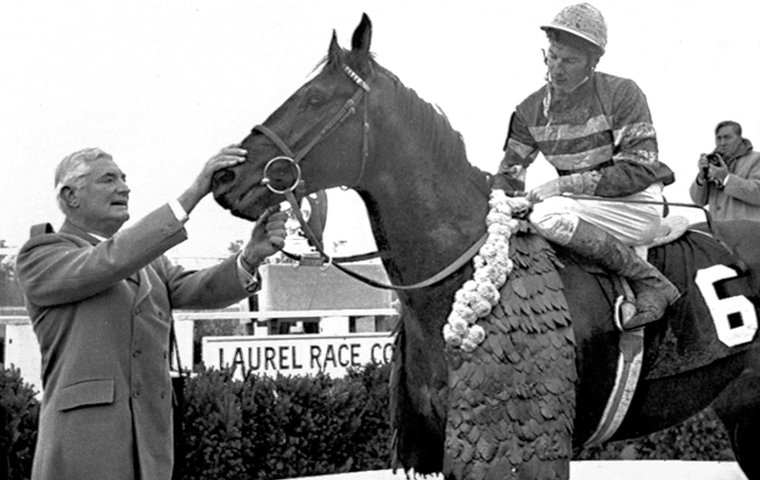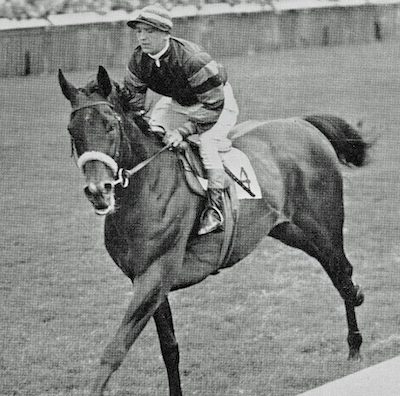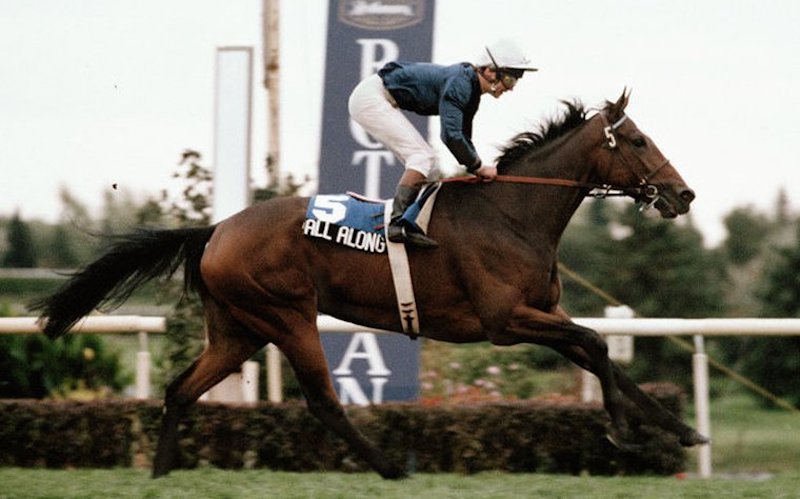
The Washington DC International is namechecked in a Grade 3 event at Pimlico on September 10. However, this descendant of a glorious original offers only a shadow of its pioneering former self, as Steve Dennis explains
USA: What do France, Venezuela, Australia, Britain and the US have in common? Five countries, four continents, one race.
Before 1952, racing was a relatively parochial sport. After 1952, it embraced a cosmopolitan outlook. The hinge that swung wide the door to global competition was the Washington DC International, a race that changed racing itself.
In its prime, the Washington DC International was the most glamorous, glorious race, with its sheer different-ness beguiling racefans from Neasden to Nashville to Nantes and Novosibirsk. It embraced the then-primitive hardships of long-haul travel, the pre-internet thrill of jockeys, trainers and horses previously known only through scattered paragraphs of greying newsprint, and the intoxicating sensation of boundaries being pushed back, of horizons opening, of a brave new world.
Now the race that changed racing has itself been changed entirely. In the 70 years since its birth it has risen to great heights, disappeared from view, been resurrected, been transformed. Between 1952 and 2022, the span of a lifetime, the Washington DC International has lived many lives.
The way we were
The inaugural running of the Washington DC International, at Laurel Park, Maryland in October 1952, drew a field of just seven, but among them the pioneering spirit was strong. International by name, international by nature.
 Two horses came from Britain, one from Germany, one from Canada, three from the US, something that had never happened before. Yes, the Derby winner Papyrus had taken on Kentucky Derby winner Zev almost 30 years earlier, and the French horse Epinard had run four times in the US the following year, but neither tourist had been successful and the trickle of foreign participation had dried up to nothing. Now the taps were on again.
Two horses came from Britain, one from Germany, one from Canada, three from the US, something that had never happened before. Yes, the Derby winner Papyrus had taken on Kentucky Derby winner Zev almost 30 years earlier, and the French horse Epinard had run four times in the US the following year, but neither tourist had been successful and the trickle of foreign participation had dried up to nothing. Now the taps were on again.
The new race was the visionary idea of Laurel’s manager John D Schapiro, who wanted to put his racecourse on the map, a map he unfolded wide.
Transporting horses by aeroplane had become much more straightforward – Papyrus and Epinard travelled by boat – and Schapiro sweetened his $50,000 prize-money pot with concessions for European runners: the race would be run on turf over a mile and a half, it would be a walk-up start (starting stalls had yet to reach Europe) and the costs of transport would be met. What Schapiro needed more than anything else was an overseas winner, to promote the venture, and his prayers were answered.
Wilwyn, trained in Newmarket by George Colling (and saddled by assistant John Waugh) and ridden by Manny Mercer, did win; the local hope Ruhe was second, Wilwyn’s compatriot Zucchero finished third and the German-trained Niederlander fourth.
Flight time for the European contingent was 28 hours, with two refuelling stops, but it took only two and a half minutes of racing to change perception forever. One racing reporter wrote that “Schapiro had done more to promote good relations between the US and the rest of the world than all the politicians in Washington”.
Twelve months later, the French-trained Worden was successful. In 1955, El Chama took the prize back to Venezuela, and Sailor’s Guide won for Australia in 1958. In between, the home team kept the spoils, a marvellously varied roll of honour that cemented the race in the international calendar and would inspire many imitations around the world, although this sincere form of flattery also planted the seeds that would eventually prove the race’s downfall.
In the 1960s, winners included all-time great and five-time US Horse of the Year Kelso and the outstanding Irish champion Sir Ivor, the first Epsom Derby winner to venture to the US since the aforementioned Papyrus and the vehicle for yet another layer of veneer in the legend of rider Lester Piggott.
Sir Ivor was a narrow winner, the push-button colt getting home by three-quarters of a length, but the locals reckoned Piggott had made a good horse look bad by somehow disguising his brilliance. A quote in the Washington Post from an anonymous jockey ran “That was the worst ride I’ve ever seen” – and if you held that sort of opinion you’d be very keen to stay anonymous.
How Virginian Raymond Guest conquered the twin peaks of British racing
The following year Piggott rode Karabas to victory and, disdainful of the by-now awestruck US press corps, replied to the question “when did you think you had the race won?” with the astringent, dismissive “about three weeks ago”.
The 1970s were dominated by France and the US, with local champion Run The Gantlet and Dahlia, the majestic French filly whose brilliance was mirrored by her toughness, the finest names on the honours board. The same nations held sway during the following decade, with Run The Gantlet’s daughter April Run successful in 1982 and the remarkable All Along victorious 12 months later.
 What All Along did in the autumn of 1983 will never be done again. In the space of 41 days the French filly won the Prix de l’Arc de Triomphe at Longchamp, the Rothmans International at Woodbine, the Turf Classic at Aqueduct and finally the Washington DC International, the latter three races offering a million-dollar bonus to any horse who could sweep the series.
What All Along did in the autumn of 1983 will never be done again. In the space of 41 days the French filly won the Prix de l’Arc de Triomphe at Longchamp, the Rothmans International at Woodbine, the Turf Classic at Aqueduct and finally the Washington DC International, the latter three races offering a million-dollar bonus to any horse who could sweep the series.
Here was the high-water mark of the Washington DC International. In 1986 the race distance was reduced to ten furlongs and the standard of winner began to slip, and the allure began to dwindle. The pioneer of international competition was being supplanted by second-generation versions that swiftly outstripped it for prestige and prize-money. The Arlington Million and Japan Cup were inaugurated in 1981, the Breeders’ Cup in 1984, and intercontinental travel quickly became commonplace.
“The timing of the race conflicted with the Breeders’ Cup, and its place on the late fall racing calendar made it difficult to attract international horses,” says Mike Rogers, the acting general manager and president of the Maryland Jockey Club.
The Washington DC International had become a victim of its own success. It was old hat, a C60 cassette in a new and glittering landscape of compact discs. After Paradise Creek’s victory in 1994 the race was discontinued, shuffling off into a quiet corner of cultural eternity along with the Twist, lunar missions, and the Berlin Wall.
Slight return
But 11 years later, as if by magic, it came back. Not as the Washington DC International but as the Colonial Turf Cup, run at Colonial Downs in Virginia, 130 miles south across the state line from Laurel Park and a whole world away. The race was re-inaugurated in June 2005 as the first leg of the ‘Grand Slam of Grass’, a turf quadruple that – oh, the irony –concluded with the Breeders’ Cup Turf.
Not only had the location changed, but also the distance – now a mile and three-sixteenths – and the prestige of the race, for it was no longer a Graded contest and naturally drew no overseas runners.
This new incarnation of an old favourite posed pertinent questions about sense of identity, of how something exists but no longer survives, as in the paradox of the Ship of Theseus and – for the amusement of British readers – Trigger’s broom.
The Colonial Turf Cup continued, trailing the fading spirit of the Washington DC International in its wake like so much untidy ectoplasm, until the race returned to Laurel Park in 2015 with yet another new name: the Commonwealth Turf Cup, now a Grade 2 run at a mile and one-eighth.
It was back home at last, and when two years later the race title was changed yet again, to the Baltimore Washington International Turf Cup, the link to its glorious past was belatedly, if a little clumsily, forged anew despite the continued reduction in race distance to a mile.
“The Baltimore Washington International Turf Cup is a nod to the race’s Maryland roots and the important connection the race has to the Maryland Jockey Club,” says Rogers. “The distance? We reviewed the east-coast stakes schedule and recognised an opportunity to have the race at a mile because there were no other races at that distance. We felt we could attract maximum field size by offering that distance.”
The last four iterations of the race have drawn fields of six, seven, seven and four. Furthermore, in yet another assault on the battered old race’s identity, the 2021 renewal was run at Pimlico in July. This year the Baltimore Washington International Turf Cup will be run at Pimlico on September 10, as a Grade 3 over a mile with a purse of $200,000. In 1994, Paradise Creek had run for a share of $600,000.
“The Maryland Jockey Club was originally scheduled to have the Pimlico meet in August, but due to unforeseen circumstances the meet was changed to September, and it was decided that the September stakes schedule would remain intact, which led to running the race at Pimlico,” adds Rogers.
Tomorrow never knows
There is an echo of what happened to the Washington DC International in what is now happening to the Arlington Million, one of the races that abetted the International’s departure from the scene. The Million has been moved to Churchill Downs, has had its distance reduced to a mile-eighth and its international importance neutered. Racing is not always conscientious of its past, but what of the future?
“There have been many discussions and ideas over the years on revitalising the race. We would be thrilled if an owner or trainer chose to use it as a prep for the Breeders’ Cup,” says Rogers, who appreciates that for many the race has a nostalgic connection that transcends its current identity.
“It is always great to hear the old stories and better understand the impact the race had on the sport in Maryland. The evolution of the race and the opportunity for a fresh generation to experience it and make it their own is part of ensuring a successful future for our sport.”
The Washington DC International has had its name, distance, location, prestige and position in the calendar altered and its importance stripped away, and among the bones of what remains is a horse race you would not cross the Atlantic for.
Yet once upon a time it changed the world.
Children of Secretariat: maintaining the famous family line to Secreto, Istabraq and Dare And Go
Eddie Delahoussaye: I don’t like having rules made by people who don’t know anything about the game
Jay Hovdey: Sandpit: nothing less than a four-legged Robert Redford
View the latest TRC Global Rankings for horses / jockeys / trainers / sires


